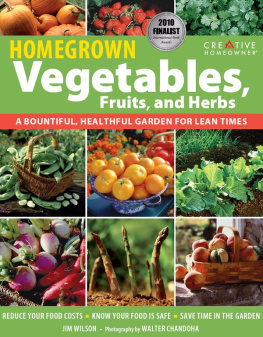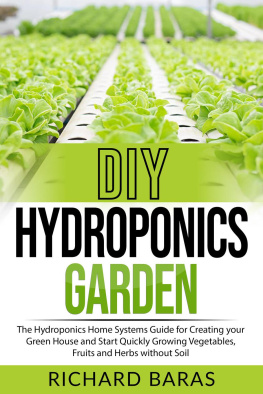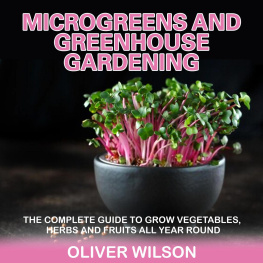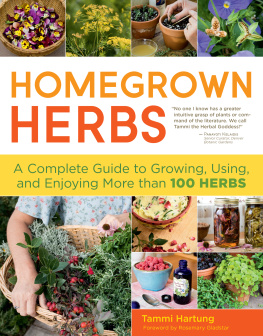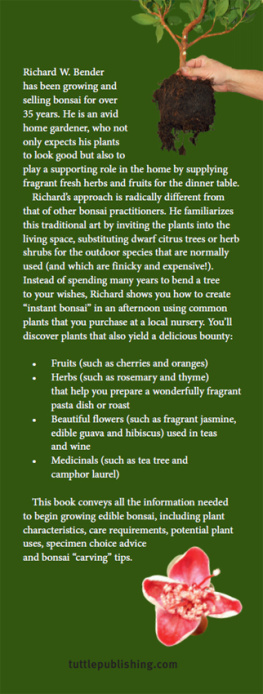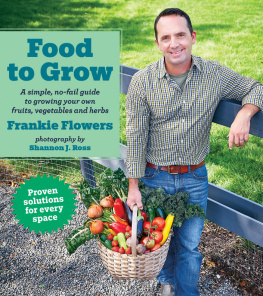Jim W. Wilson - Homegrown Vegetables, Fruits & Herbs: A Bountiful, Healthful Garden for Lean Times
Here you can read online Jim W. Wilson - Homegrown Vegetables, Fruits & Herbs: A Bountiful, Healthful Garden for Lean Times full text of the book (entire story) in english for free. Download pdf and epub, get meaning, cover and reviews about this ebook. year: 2017, publisher: Fox Chapel Publishing, genre: Children. Description of the work, (preface) as well as reviews are available. Best literature library LitArk.com created for fans of good reading and offers a wide selection of genres:
Romance novel
Science fiction
Adventure
Detective
Science
History
Home and family
Prose
Art
Politics
Computer
Non-fiction
Religion
Business
Children
Humor
Choose a favorite category and find really read worthwhile books. Enjoy immersion in the world of imagination, feel the emotions of the characters or learn something new for yourself, make an fascinating discovery.
- Book:Homegrown Vegetables, Fruits & Herbs: A Bountiful, Healthful Garden for Lean Times
- Author:
- Publisher:Fox Chapel Publishing
- Genre:
- Year:2017
- Rating:4 / 5
- Favourites:Add to favourites
- Your mark:
- 80
- 1
- 2
- 3
- 4
- 5
Homegrown Vegetables, Fruits & Herbs: A Bountiful, Healthful Garden for Lean Times: summary, description and annotation
We offer to read an annotation, description, summary or preface (depends on what the author of the book "Homegrown Vegetables, Fruits & Herbs: A Bountiful, Healthful Garden for Lean Times" wrote himself). If you haven't found the necessary information about the book — write in the comments, we will try to find it.
Jim W. Wilson: author's other books
Who wrote Homegrown Vegetables, Fruits & Herbs: A Bountiful, Healthful Garden for Lean Times? Find out the surname, the name of the author of the book and a list of all author's works by series.
Homegrown Vegetables, Fruits & Herbs: A Bountiful, Healthful Garden for Lean Times — read online for free the complete book (whole text) full work
Below is the text of the book, divided by pages. System saving the place of the last page read, allows you to conveniently read the book "Homegrown Vegetables, Fruits & Herbs: A Bountiful, Healthful Garden for Lean Times" online for free, without having to search again every time where you left off. Put a bookmark, and you can go to the page where you finished reading at any time.
Font size:
Interval:
Bookmark:

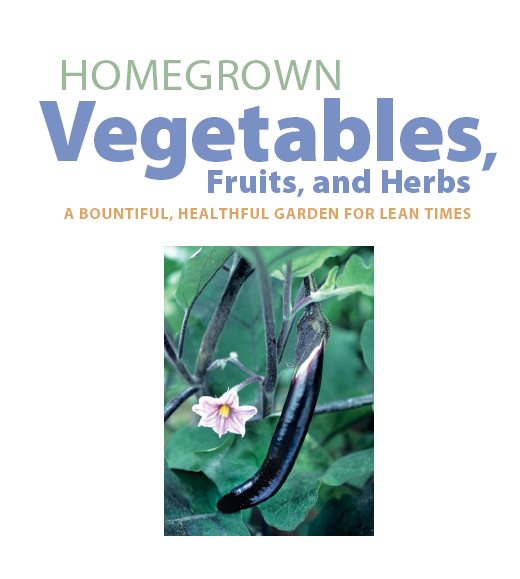


This book is dedicated to the certified Master Gardeners of the USA and Canada, and especially to my Missouri Master Gardener, Janie Mandel, who has kept me from being overwhelmed by digital technology. J.W.
Much of the material on these pages began as a syllabus I wrote for a course on Advanced Master Gardening and as a manual for coordinators of community gardens. During the process of turning it into this book, I learned as much as I contributed. I want to thank the editors and graphics specialists at Creative Homeowner for their masterly pruning of wordy passages and their elegant application of Walter Chandohas images. J.W.
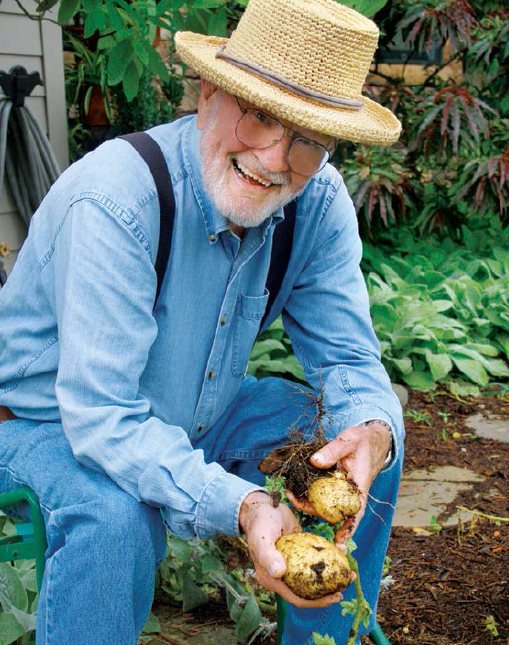

ALL PROJECTS AND PROCEDURES in this book have been reviewed for safety; still it is not possible to overstate the importance of working carefully. What follows are reminders for plant care and project safety. Always use common sense.
Always consider nontoxic and least toxic methods of addressing unwanted plants, plant pests, and plant diseases before resorting to toxic methods. Follow package application and safety instructions carefully.
Always substitute rock phosphate and gypsum for bonemeal when amending soil. Authorities suggest that theres a hazard in using bovine-based products such as bonemeal, blood meal, and cow manure because they could harbor the virus that causes mad cow disease in cattle and humans.
Always read labels on chemicals, solvents, and other products; provide ventilation; heed warnings.
Always wear eye protection when using chemicals, sawing wood, pruning trees and shrubs, using power tools, and striking metal onto metal or concrete.
Always wear a hard hat when working in situations with potential for injury from falling tree limbs.
Always wear appropriate gloves in situations in which your hands could be injured by rough surfaces, sharp edges, thorns, or poisonous plants.
Always wear a disposable face mask or a special filtering respirator when creating sawdust or working with gardening dusts and powders.
Always protect yourself against ticks, which can carry Lyme disease. Wear light-colored, long-sleeved shirts and pants. Inspect yourself for ticks after gardening.
Always determine locations of underground utility lines before you dig, and avoid them by a safe distance. Buried lines may be for gas, electricity, communications, or water. Contact local utility companies, which will help you map their lines.
Always read and heed tool manufacturer instructions.
Always ensure that the electrical setup is safe; be sure that no circuit is overloaded and that all power tools and electrical outlets are properly grounded and protected by a ground-fault circuit interrupter (GFCI). Do not use power tools in wet locations.
Always keep your hands and other body parts away from the business ends of blades, cutters, and bits.
Never use herbicides, pesticides, or toxic chemicals unless you have determined with certainty that they were developed for the specific problem you hope to remedy.
Never allow bystanders to approach work areas where they might by injured by workers or work-site hazards.
Never work with power tools when you are tired or under the influence of alcohol or drugs.
Never carry sharp or pointed tools, such as knives or saws, in your pocket.
Fat August is the season of plenty. Braids of onions hang to dry in the attic, pickles swim in tubs of brine, jars of canned tomatoes cool by the stove. There is joy in this abundance, joy in the faces of friends who crowd around our kitchen table for dinner, joy in watching them empty one platter after another.
We make no claim to total self-sufficiency. We are no strangers to the supermarket. We have jobs and medical coverage, the burdens and benefits of modern life. But every year we plant a vegetable garden, and we are the better for it.
Its more than economics. Yes, we usually end up with more homegrown food than we can consume on our own, though there are fewer calories in daikon than in doughnuts. And there are the grocery dollars saved.
Only a couple of us will ever become real farmers. But to raise something edible from seed is to bring forth sustenance from the earth. Raise your own sweet corn or a few potatoes, and you get a sense of where food comes from, a fresh respect for those who feed us. Serve those same vegetables, and you will be eating well indeed, for greatness in the kitchen begins in the garden.
While you will not be able to grow everything yourself, you will learn to appreciate farmers markets and other local sources. You will find yourself seeking and celebrating the new, the unfamiliar, the delicious. For from a few small seeds, champion vegetables and vegetable champions are born.
Roger B. Swain
Host, PBS-TVs The Victory Garden



B ack in 2007, few Americans could have been persuaded to plant a food garden or to enlarge an existing vegetable patch. Then the economy began to unravel. Today, many families are looking for ways to reduce costs and to eat healthier, fresher, better-tasting food.
Food gardens, which for several decades took a backseat to ornamental landscapes, have begun to sound like a good idea to many folks with a sunny yard. This resurgence of interest inand need for homegrown food was what convinced my friend and colleague Walter Chandoha and me to come out of blissful retirement to create this book. Our goal is to help aspiring gardeners avoid the disappointment or downright failure that often comes with the first attempts at cultivating produce. We also hope to convince families who are already growing food crops to grow more, both for themselves and for the needy in their communities.
Through the advice and recommendations offered in Homegrown Vegetables, Fruits, and Herbs, we aim to hold the hand of the new gardener through that first year, when the learning curve is so steep that a novice can feel overwhelmed. Both Walter and I have mentored many a young gardener and have designed this book to be our surrogate. Most of all, we want to assure families that when the going gets tough, a big food garden can be like a friend indeed. It wont attempt to entertain you, but it will enlighten you andeventuallyrepay all the time and attention you have invested in it with a bounty of delicious gifts.
Font size:
Interval:
Bookmark:
Similar books «Homegrown Vegetables, Fruits & Herbs: A Bountiful, Healthful Garden for Lean Times»
Look at similar books to Homegrown Vegetables, Fruits & Herbs: A Bountiful, Healthful Garden for Lean Times. We have selected literature similar in name and meaning in the hope of providing readers with more options to find new, interesting, not yet read works.
Discussion, reviews of the book Homegrown Vegetables, Fruits & Herbs: A Bountiful, Healthful Garden for Lean Times and just readers' own opinions. Leave your comments, write what you think about the work, its meaning or the main characters. Specify what exactly you liked and what you didn't like, and why you think so.

